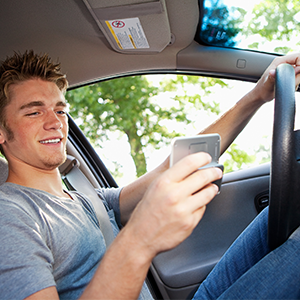Your child is 16, has passed the driving test and clutches his newly minted driver’s license in hand. You have lectured him about being safe on the road. No texting, no talking on the phone, use your turn signals and check your mirrors often. But will he listen and is he really safe?
Unfortunately the answer is more complicated than yes or no. According to the American Automobile Association Foundation for Traffic Safety, car crashes are the leading cause of death among people ages 16 – 20 in the United States with more than 5,600 fatalities on the road annually. As many as 16 percent of all fatal crashes have a contributing factor of distracted driving; such as cell phone use, eating behind the wheel, changing the radio station and even applying makeup.
There are things you can do about it though, according to Dr. David Kidd, Senior Research Scientist at the Insurance Institute for Highway Safety (IIHS). “One of the best things you can do is model good behavior yourself,” he says. “ When you are teaching a child to do anything, they learn through observation, so you need to demonstrate what you want them to do. Tell them and then show them.”
Doug Herbert, professional drag car racer and the founder of Be Responsible and Keep Everyone Safe (B.R.A.K.E.S.) agrees. “Kids have been watching you drive since they were in a car seat,” Herbert says. “You can’t expect them to do things right if they are seeing you do things wrong.”
Herbert himself lost two children to a fatal car crash when his son lost control of his car and drifted into oncoming traffic. “No parent should have to get that call,” Herbert says. “In an instant, I lost both of my sons.”
With his tragedy in mind, he founded B.R.A.K.E.S., a driving school with the aim to teach teen drivers, and their parents, about the dangers of distracted driving. “We put these kids in a car and take them through a distraction course,” he says. “They hit cones, they veer, they lose control and hopefully, they learn.”
The AAA Foundation for Traffic Safety calculates that teen drivers crash more than four times as often as adults, and a major contributing factor is that they are distracted almost one-quarter of the time they are behind the wheel of a moving car. “And it’s not just them they are endangering,” Kidd says. “It’s everyone on the road.”
One of the most concrete steps you can take to help ensure your child’s safety on the road is to limit the number of passengers. For each additional teenage passenger in a car, the chance of an accident doubles. Kidd recommends not only restricting the number of passengers, but also limiting night time driving. “If your state doesn’t have a graduated licensing program, look to other states to see what they are doing,” he says. “These programs are evaluated and based on research and they are effective in reducing crashes.”
Kidd also stresses the importance of putting teen drivers in safe cars. “Look for features on the vehicle you have,” he says. “Drivers should not use crash avoidance technologies as their first line of defense, but they do help. They can help mitigate some consequences.”
Herbert encourages teens to get themselves out of a dangerous situation when they are passengers in a car. “When someone is driving badly, you need to say ‘hey get off the phone or let me out of the car.’ Don’t be afraid to stand up for yourself and get out of a dangerous situation.”
Resources:
-
For more on how you can protect your child behind the wheel read:
washingtonparent.com/articles/1504/1504-teen-driving-risks.php -
And for a Dad’s perspective on his daughter’s risky ride of passage take a look at:
washingtonparent.com/articles/1511/1511-a-risky-ride-of-passage.php


